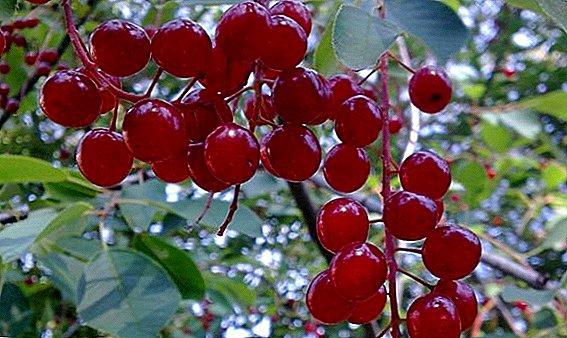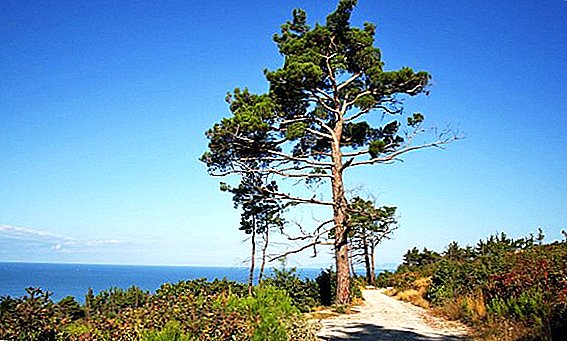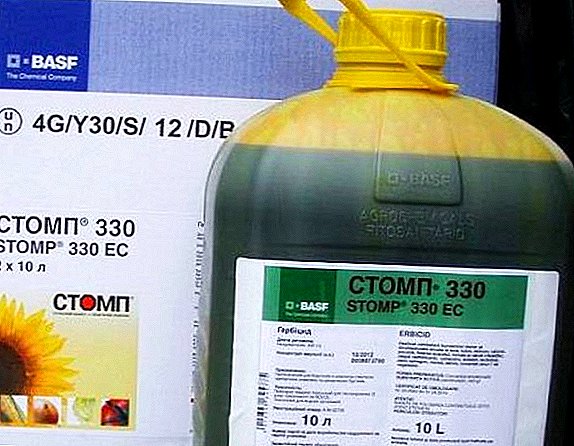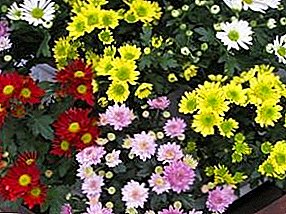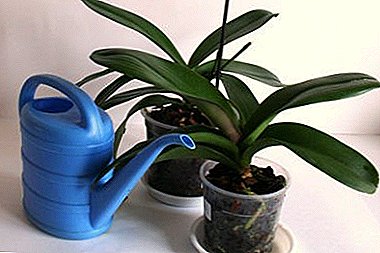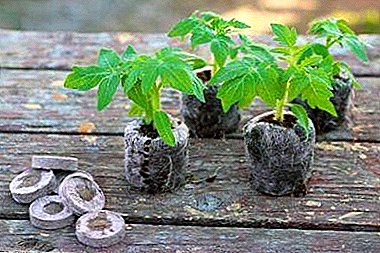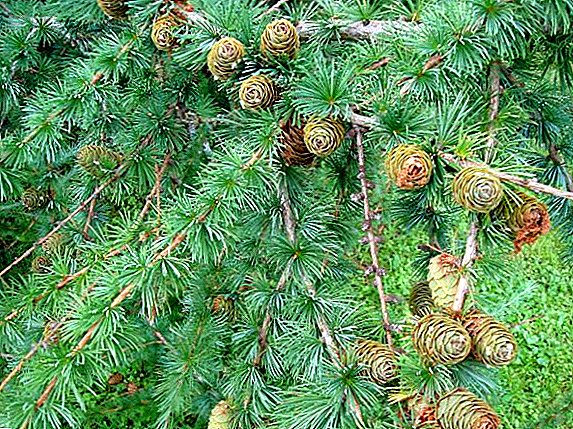 Coniferous trees in all seasons can decorate any yard, cottage, park. Due to their beauty and not particularly capriciousness, they are popular both among the owners of private yards, and among people who are professionally engaged in landscape design. One of the unusual and attractive conifers is larch (lat. Larix) - powerful tree (up to 35-40 m in height) from the pine family. The unusualness of this taiga beauty lies in the soft flat needles, which, unlike the fellows, this plant falls before winter. In autumn, trees turn yellow or bright orange. Thus, larch is not an evergreen coniferous plant.
Coniferous trees in all seasons can decorate any yard, cottage, park. Due to their beauty and not particularly capriciousness, they are popular both among the owners of private yards, and among people who are professionally engaged in landscape design. One of the unusual and attractive conifers is larch (lat. Larix) - powerful tree (up to 35-40 m in height) from the pine family. The unusualness of this taiga beauty lies in the soft flat needles, which, unlike the fellows, this plant falls before winter. In autumn, trees turn yellow or bright orange. Thus, larch is not an evergreen coniferous plant.
The genus of larches has about 20 species that grow in the mountains and forests of the Northern Hemisphere. It belongs to plants-long-livers - lives 500 years or more.  Due to its strength, durability and resistance to decay, the wood of trees has a value, it is used in shipbuilding, for the construction of underwater structures, the manufacture of parquet and furniture. From the needles of larch receive essential oil. A useful resin is extracted from the bark. After a description of the attractive qualities of larch, many will probably want to plant it in their yard, in front of the house, in the country or in a flower bed. Detailed information about the features of planting, growing, care and use of beauty-larch can be found in this article.
Due to its strength, durability and resistance to decay, the wood of trees has a value, it is used in shipbuilding, for the construction of underwater structures, the manufacture of parquet and furniture. From the needles of larch receive essential oil. A useful resin is extracted from the bark. After a description of the attractive qualities of larch, many will probably want to plant it in their yard, in front of the house, in the country or in a flower bed. Detailed information about the features of planting, growing, care and use of beauty-larch can be found in this article.
Did you know? Two species of larches are protected plants: Polish and Olgin.
What to look for when buying seedlings
How to grow larch? There are two ways - saplings or seeds. Seedlings need to choose two to four years. It is better to purchase plants in containers. When buying, pay attention to the tips of the needles - they should not be dry. The branches should bend and not bend to the sides.
Important! When buying a sapling, go not to popular shopping supermarkets, but to a nursery or horticultural center. So you will have the right guarantee to buy a high-quality healthy seedling and not throw money away.
However, sometimes to buy larch seedlings is quite difficult. Therefore, it is often sown with seeds, which are extracted independently from cones at the end of October or purchased in specialized stores. Before planting, they must be stored in a paper bag. Germination seeds retain for two to three years.
Choosing a landing site
It is necessary to approach the choice of a place for planting larch with full responsibility, since the tree categorically refuses to grow in the shade. For it is necessary to choose a sunny corner.
Did you know? Only one species of larch can grow in light shading - Japanese.
 If you dream of planting this beauty, but in the country there is no room for such a large and sprawling plant, you can form a small tree for yourself by pruning. Fortunately, the larch tolerates this procedure well and is restored very quickly after it. Therefore, before you land this cone, you have to look for information about how to cut it and, perhaps, to get acquainted with the art of bonsai. Also for planting, you can pick up decorative varieties of small sizes. Larch is demanding on the composition of the soil. It does not suit acidic soils, therefore, if on the plot planned for it is acidic earth, it should be leached before planting. With difficulty, the tree takes root on poor and sandy soils. In addition, it will not be superfluous to know that the root system of larch does not tolerate close occurrence of groundwater. In order for the tree to settle down quickly and successfully, it must be planted in a well-drained soil rich in humus. Larch tolerates the conditions of the city well, so it can be planted in city parks, squares, and courtyards. Very resistant to frost.
If you dream of planting this beauty, but in the country there is no room for such a large and sprawling plant, you can form a small tree for yourself by pruning. Fortunately, the larch tolerates this procedure well and is restored very quickly after it. Therefore, before you land this cone, you have to look for information about how to cut it and, perhaps, to get acquainted with the art of bonsai. Also for planting, you can pick up decorative varieties of small sizes. Larch is demanding on the composition of the soil. It does not suit acidic soils, therefore, if on the plot planned for it is acidic earth, it should be leached before planting. With difficulty, the tree takes root on poor and sandy soils. In addition, it will not be superfluous to know that the root system of larch does not tolerate close occurrence of groundwater. In order for the tree to settle down quickly and successfully, it must be planted in a well-drained soil rich in humus. Larch tolerates the conditions of the city well, so it can be planted in city parks, squares, and courtyards. Very resistant to frost.
Best time to land
If you plan to plant a seedling, then it should be done in the fall, after leaf fall, or in early spring, when the soil has warmed slightly. Seeds are sown in spring in a well-warmed land, when there is already grass on it.
Landing tips
For planting seedlings pre-prepare a hole with dimensions of 50 by 50 cm. If a tree is planted from a container, the pit should be twice as wide and deeper than the container. The plant is neatly placed in it, trying not to damage the clod of earth with the root system. Top sleep with a mixture of sod land with peat in equal proportions. At the same time, the root neck should remain on the surface. If the soil is heavy, sand (one part) can be added to the mixture, and drainage should be placed at the bottom of the planting pit. After planting, the tree is watered abundantly using at least a bucket of water. Possible to make compost or humus. Young planting must be sheltered from direct sunlight and cold weather.
Important! When planting larch seedlings need to be very careful and not to touch the apical shoots. Even a light touch can harm the tree - lead to its curvature, which will remain at the conifer for life.
 More time consuming is the process of seed planting. For better germination, larch seeds must be stratified (however, this procedure is optional). To do this, a month before planting, soak them in water at room temperature for 48 hours. Next, you need to carry out their culling: remove the seeds that surfaced. After that, in any container they must be mixed with moistened sand (1: 3) and put in a refrigerator, on the lower shelf, adjusting the temperature from 0 to +5 ° С. The duration of stratification is 20-30 days.
More time consuming is the process of seed planting. For better germination, larch seeds must be stratified (however, this procedure is optional). To do this, a month before planting, soak them in water at room temperature for 48 hours. Next, you need to carry out their culling: remove the seeds that surfaced. After that, in any container they must be mixed with moistened sand (1: 3) and put in a refrigerator, on the lower shelf, adjusting the temperature from 0 to +5 ° С. The duration of stratification is 20-30 days.
Sowing produced in late April - early May. Seeds deepen into the soil by 0.5-1 cm. The distance between the rows is 10-12 cm. From above, seeds are sprinkled with sand and peat substrate (3: 1). Crops mulch. After the sprouts appear, after about two weeks, the mulch layer is removed. Caring for larch seedlings involves regular watering, treatment with fungicides against diseases and pests of conifers, thinning and weeding. When young plants reach two years of age, they are transplanted to a permanent place.
Larch tolerates planting difficult and long. However, when it takes root, it will please with fast growth rates - from 1.5 to 3.5 cm per year for the first 20 years. In four to five years, reaches a height of 1.5 m. At the age of 10, under favorable growing conditions, it begins to bear fruit.
Care and cultivation of larch
Larch does not require too much attention when growing. In principle, like most other plants, it needs to be watered regularly, loosened the soil in the circle around the trunk, rid of the surrounding weeds, feed them with nutrients and trim if necessary.
Watering, weeding and loosening the soil
Larch has such a feature as drought intolerance. Therefore, watering of young plants (up to two years), as well as adult specimens during dry periods, must be mandatory. Approximate water consumption - 20 liters per one mature tree once or twice a week.
Did you know? Larch is recommended to be watered with water, which was used for washing mushrooms.
 As for loosening and weeding, only youngsters require it. Adult plants can easily do without this procedure. To make some species of coniferous beauty attractive, its branches can be cut off, giving interesting forms to crowns (openwork hedges, crowns, balls, etc.) and holding back growth. Only young larches are pruned.
As for loosening and weeding, only youngsters require it. Adult plants can easily do without this procedure. To make some species of coniferous beauty attractive, its branches can be cut off, giving interesting forms to crowns (openwork hedges, crowns, balls, etc.) and holding back growth. Only young larches are pruned.
Fertilization
In the first year after planting, in May, the young plant can be fertilized with complex fertilizer - Kemira Universal (20 g / 1 sq. M) will approach or feedings containing potassium and magnesium. In early summer, to improve the decorative qualities of the needles, the crown is poured over with a watering can with a solution of urea (10 g / 10 l of water). In the future, you can annually in early spring, before the beginning of the growth of shoots, to apply fertilizer for conifers.
Soil mulching
The soil is mulched with a layer of 5-6 cm immediately after planting, using straw, peat, sawdust, pine needles. Even the most severe winters larch tolerates very well and does not require additional measures to prepare for the cold. However, young plants, especially on the trunk, it is better to wrap sacking. Some species will also need a garter of the branches so that they do not break off under the weight of the snow cover.
Larch on a trunk and in landscape design
 Larch is widely used in landscape design. Due to the fact that it is represented not only by large trees, but also by miniature varieties, its area of application is very extensive. It is planted in group and soliternyh plantings, as hedges, in rocky gardens and rock gardens. The tree tolerates the neighborhood with other plants. The best partners for it may be conifers, rhododendrons, linden, birch, maple, mountain ash, juniper, viburnum, barberry.
Larch is widely used in landscape design. Due to the fact that it is represented not only by large trees, but also by miniature varieties, its area of application is very extensive. It is planted in group and soliternyh plantings, as hedges, in rocky gardens and rock gardens. The tree tolerates the neighborhood with other plants. The best partners for it may be conifers, rhododendrons, linden, birch, maple, mountain ash, juniper, viburnum, barberry.
The compact larch on the trunk is beautiful and unusual. Usually for cultivation in this way using varieties of European larch Kornik, Repens, Japanese: Blue Dwarf, Stiff Weeper. They can have different types of crowns: weeping, creeping, in the form of a pillow, as well as various colors of needles: dark green, gray-blue. Very nicely the standard varieties look near the places of rest, on the lawn, at the entrance to the buildings, in the alpine hills, openwork hedges.
There are dwarf varieties of larch (for example, Wolterdingen), which are great for planting in containers and found use in the design of Japanese gardens.
Diseases and pests of larch, methods of dealing with them
Like all conifers, larch has a number of enemies in the form of pests, fungi and bacteria. The most dangerous disease for a tree is larch cancer, which affects the leaves and trunk. They form smooth shiny spots, cracks appear in the cortex, and gum bleeding. The most vulnerable for this disease are plants from 3 to 40 years old, European and Siberian varieties.  Seedlings can catch fusarium. To prevent this disease, the treatment of soil and seed material with a solution of potassium permanganate, preparations containing copper, "Fundazole" is used. It affects larch and shyutte. Symptoms of the disease are red spots on the leaves, needles in May. Later, the needles turn yellow and fall off. For the prevention of this disease using spring spraying "Zinebom" Bordeaux liquid, a solution of colloidal sulfur.
Seedlings can catch fusarium. To prevent this disease, the treatment of soil and seed material with a solution of potassium permanganate, preparations containing copper, "Fundazole" is used. It affects larch and shyutte. Symptoms of the disease are red spots on the leaves, needles in May. Later, the needles turn yellow and fall off. For the prevention of this disease using spring spraying "Zinebom" Bordeaux liquid, a solution of colloidal sulfur.
Against tinder, root sponge used treatment "Nitrofen", copper sulphate. Among the pests, the moth moth, whose caterpillars feed on needles, causes very great harm to the decorative effect of larch. To exterminate them, apply treatment with insecticides. The affected branches are removed.
Pine needles are also harmed by striped deciduous sawflies, deciduous spider moths. The juice of the plant feeds on brown aphids and greenish hermes. The needles become yellow and curved. Insecticides, in particular Fozalon, Chlorofos, are used to fight.
 Also, the tree is amenable to attacks of coniferous worms. The bark and crown are damaged by bark beetles, barbs, and beetles. To combat them effective spring spraying "Karbofos", "Nitrofen". Cones and seeds eat the caterpillars of the cone-shaped moth. Here infusions and decoctions of insecticidal plants can help. Larch - a tree with character, however, if you satisfy all its requirements, then it will for a long time please you with its beautiful lush crown and soft leaves, needles that cannot be broken.
Also, the tree is amenable to attacks of coniferous worms. The bark and crown are damaged by bark beetles, barbs, and beetles. To combat them effective spring spraying "Karbofos", "Nitrofen". Cones and seeds eat the caterpillars of the cone-shaped moth. Here infusions and decoctions of insecticidal plants can help. Larch - a tree with character, however, if you satisfy all its requirements, then it will for a long time please you with its beautiful lush crown and soft leaves, needles that cannot be broken.



